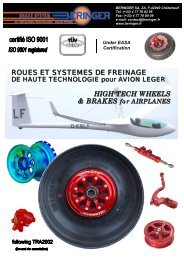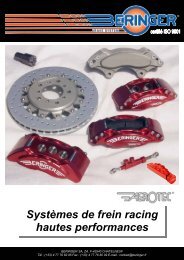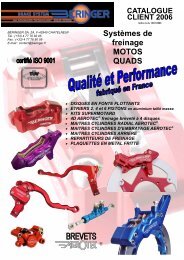High tech Racing braking systems - Beringer.fr
High tech Racing braking systems - Beringer.fr
High tech Racing braking systems - Beringer.fr
Create successful ePaper yourself
Turn your PDF publications into a flip-book with our unique Google optimized e-Paper software.
Made <strong>fr</strong>om blocks<br />
Béringer uses a high-performance aeronautic<br />
alloy, which is used on the wings of supersonic<br />
fighter planes. The resistance of this alloy is more<br />
than twice that of the original callipers and can be<br />
used in high temperatures.<br />
Résistance Strength élastique in Mpa<br />
400<br />
300<br />
180<br />
140<br />
Aeronautic alloy (<strong>Beringer</strong> caliper)<br />
Alliage aéronautique (étriers BERINGER)<br />
Foundry alloy (conventional caliper)<br />
Alliage de fonderie (étriers d’origine)<br />
0<br />
Temperature<br />
Température °C<br />
200<br />
Machining <strong>fr</strong>om a block on NC machines ensures perfect control of<br />
thickness and a saving of weight <strong>fr</strong>om 30 % to 40 %, compared<br />
with the original callipers. This precision machining is the guarantee<br />
of fine control in the power of <strong>braking</strong>.<br />
Tests of brake pad wear:<br />
After 60,000 km, the slantwise wear on both pads is less than 0.1 mm on a daily used car<br />
and less than 0.4 mm on a racing car !<br />
Results of the different tests<br />
Tests of use in adverse conditions:<br />
Despite the mud and sand, the guide bars continue to operate perfectly and safeguard the<br />
properties of the calliper whatever the conditions.<br />
Improvement of vehicle control with ABS<br />
Official tests on <strong>braking</strong> carried out by UTAC:<br />
These tests were carried out in the real conditions of automobile certification. They proved the effectiveness of<br />
the guide bars and the impact on the ABS operation.<br />
The wheels are locked by a very strong pressure on the brake pads. The ABS system releases the pressure when<br />
this locking occurs so that the tyres regain their adherence and then exerts pressure again so that the vehicle<br />
brakes. During emergency <strong>braking</strong>, there is a succession of to- and <strong>fr</strong>o movements of the brake pads.<br />
Thanks to the patented brake pad guides, the caliper optimises operation of the ABS by unlocking the wheel<br />
more rapidly and limiting the time during which the wheel is locked. On dry ground better control of the vehicle<br />
is seen.<br />
Reduction of <strong>braking</strong> distance on wet roads !<br />
On surfaces where adherence is poor, ABS is particularly necessary. The adherence factor on wet<br />
ground of a moving vehicle is 0.3 (1.1 on dry ground), and only 0.1 when the wheels are locked –<br />
three times less!<br />
The UTAC test showed that for an upmarket sports vehicle equipped with a V6 3.0 l engine and reputable<br />
brakes, the <strong>braking</strong> distance <strong>fr</strong>om 80 to 0 kph on wet ground is reduced by 8.8 metres! Remember that a<br />
pedestrian crossing is 5 meters wide.





